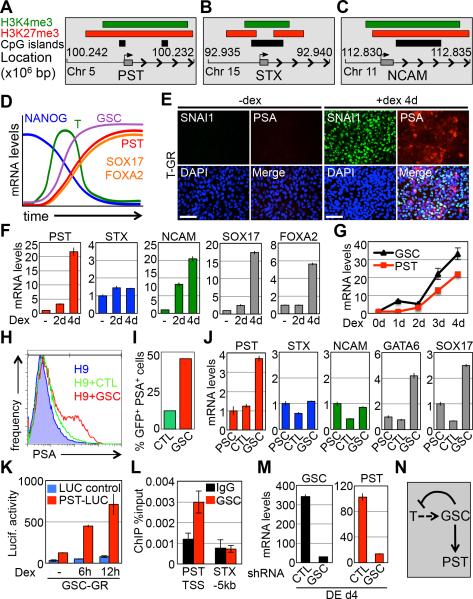Figure 3.
Polysialylation is bivalently regulated with PST under the control of the T/GSC network. (A-C) Graphical representation of H3K4me3, H3K27me3, and CpG islands at the PST (A), STX (B), and NCAM (C) genomic loci in WA01 hPSCs (Data from the UCSC genome browser database [33]). (D) Graphical illustration of gene kinetics during DE differentiation. (E) Immunostaining comparison of T-GR expression of PSA and SNAI1 after 4 day addition of Dex compared to −Dex. Scale bar, 100μm. (F) qPCR of genes in T-GR cells −Dex, +Dex 2d, and +Dex 4d. (G) Transcript analysis of GSC and PST over 4 day time course addition of Dex in T-GR cells. (H) Flow cytometry for surface PSA expression in hPSCs, hPSCs+GFP, and hPSCs+GSC-GFP 24h post electroporation. (I) Analysis of the percentage of GFP+/PSA+ cells from Fig. 4H. (J) qPCR of samples from Fig. 4H. (K) Luciferase assay of hPSCs transfected with GSC-GR, PST-LUC, and LUC-Control after Dex addition for 0, 6, and 12h. (L) GSC ChIP assay in hPSCs transfected with GSC-GFP. Genomic primers used probe the TSS of the PST promoter and the STX −5kb upstream region shown as negative control. (M) qPCR of DE d4 cells transduced with shRNA targeting GSC compared to control shRNA. (N) Diagram of proposed interaction of T, GSC, and PST. Abbreviations: hPSC, human pluripotent stem cell; Dex, dexamethasone; GR, glucocorticoid receptor; DE, definitive endoderm; LUC, luciferase; TSS, transcription start site; CTL, control.

